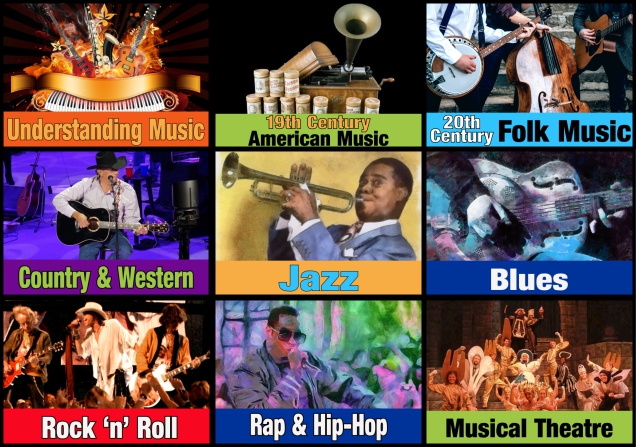AmPopMusic is divided into nine separate “Study Units”: eight units centering on the birth and history of musical genres pivotal in American musical culture, and one “preparatory” unit – “Understanding Music”.
Though many students enter the study with some previous musical background, for those who are unfamiliar with concepts such as “pitch”, “harmony”, “instrumentation”, “structure”, or “tempo”, this first AmPopMusic Study Unit can be incredibly helpful to get a grasp on the concepts and terminology common to all music – certainly those permeating American culture.
While any of the other eight Study Units in AmPopMusic can be studied independent of one another, and technically in any order chosen by a teacher, there is benefit to follow the “19th Century” through “Rap & Hip-Hop” – Study Units #2 through #8 in a specific order.
Each of the Study Units in AmPopMusic contains reading chapters, audio playdecks, video examples, study questions, and quizzes specifically organized in chronological historic order.

AmPopMusic Study Units
- What is pitch?
- What is rhythm (pulse)?
- What is volume?
- What is tone?
- What is melody?
- What is counter-melody?
- What is harmony?
- What is bass?
- What is rhythm?
- Comparing the 5 layers in different styles of music
- What is structure?
- What is instrumentation?
- Listening to the instruments
- What is tempo?
- 19th Century American Popular, Classical and Folk Music
- Stephen Foster: Father of American Popular Music
- Scott Joplin: King of Ragtime
- John Philip Sousa: Moving Into the Modern Era – Marches & Copyright Law
- John Lomax: Recording the Roots
- Woody Guthrie: Father of American Folk Music
- Leadbelly & Pete Seeger: End of the First Wave
- The Kingston Trio: Buying Back America’s Trust
- Joan Baez: First Lady of American Folk Music
- Peter, Paul & Mary: Balancing the Message
- Bob Dylan: The Prophet Who Left His People
- Conclusion: Folk Music Redefined for Today
- Hillbilly to Early Country: Backwoods to the Radio
- Cowboys & Western Swing
- Honky-tonk & Bluegrass
- Rockabilly & the Nashville Sound
- Country Feminists Find Their Voice
- Bakersfield & Austin “Outlaw”: Electric Guitar & a Beat
- Neo-Traditionalists & Contemporary Country
- Country & Western Music in the 21st Century
- What makes it “Jazz”?
- Beginnings: Before it was “Jass”
- New Orleans: Jazz is Born!
- Early Jazz Musicians
- Louis Armstrong: “Father of Modern Jazz”
- Chicago: Jazz Hub of the 1920’s
- Big Band: Jazz Swings!
- Big Band Musicians & Singers
- Jump & Bop: Jazz Radical
- Cool Jazz: Complex & Aloof
- Hard Bop: Here We Bop Again!
- Free Jazz: Breaking the Rules
- Fusion: The “Jazz-Rock-Funk” Experience
- Third Stream and World Jazz
- New Age and Smooth Jazz
- Summary: Jazz Lives!
- Introduction: Grand-daddy Blues
- Where Did the Blues Come From?
- What are the Blues?
- How to Build the Blues
- Delta & Classic Blues: The Early Years
- Blues in the City: The Middle Years
- British Blues: The Renaissance
- Contemporary Blues: Maturity and Respect
- Conclusion: The Relevancy of the Blues Today
The 1950’s
- Starting Points: Timelines, Cultures, Styles & Technology
- Pre-Rock: Influences from Jazz, Blues, Country & Gospel
- Rock is Born: Renegades of a New Sound
- The New Sound is Named: “Rock ‘n’ Roll”
- Doo-Wop: From the Streets to the Studio
- The Commercialization of Rock ‘n’ Roll
The 1960’s
- Crafting Rock ‘n’ Roll in the Studio: Producers & Hit Songs
- West Coast Sound: Beach, Surf & Teens
- Two Prongs of the British Invasion: Pop-Rock & Blues-Rock
- Motown: Developing the Black Pop-Rock Sound
- Soul: Gospel and R&B in the Deep South
- Bubble-Gum Rock: The Sounds of Teenybopper Pop-Rock
- Folk-Rock of the Mid-1960’s
- Psychedelic Rock: Soundtrack for the Drug Trip
- Guitar Legends of ‘60’s Rock
- The ‘60’s Rock Festivals
- Anti-Woodstock & Shock-Rock Movements
The 1970’s
- Country-Rock & Southern Rock: Updated Roots Music
- Jazz-Rock & Rock-Jazz
- Art-Rock: Rising Above Commercialism
- Glam-Rock: Costumes, Make-up & Androgynes
- Heavy Metal and Hard Rock of the ‘70’s and ‘80’s
- Singer-Songwriters: Rock Minimized
- Soft Rock: ‘70’s Rock Commercialized
- Funk: Rock With An Updated Groove
- Disco: Dancing Beats and Mirror Balls
- Punk: Three Chords and An Attitude
- Technological Breakthroughs
- Electronic Dance Music
- Hip-hop & Rap: An Introduction
- Old School Rap: Characteristics and Pioneers
- Rap’s Golden Age: Characteristics and Pioneers
- East Coast – Political Rap: Characteristics & Pioneers
- West Coast – Gangsta Rap: Characteristics & Pioneers
- Pop and Party Rap: Characteristics and Pioneers
- Alternative and Jazz-Rap: Characteristics and Pioneers
- The Importance of Rap
- Musical Stage Productions in the 18th Century America
- Minstrel Shows and Melodramas
- 19th Century: Extravaganzas, Spectacles, Burlesque, and Vaudeville
- Early 20th Century: Revues and Operettas
- The Arrival of the Modern American Musical
- Partnerships in Book-Musicals
- Musical Theatre in the jmid-20th Century
- Fresh Voices on the Stage in the 1960s
- Two Dominant Forces at the end of the 20th Century
- New Voices at the end of the 20th Century
- New Sounds, New Ideas, New Century

